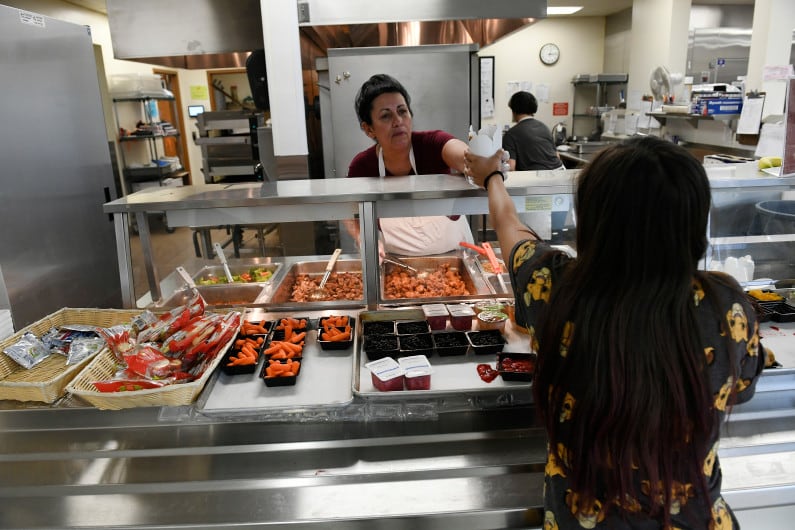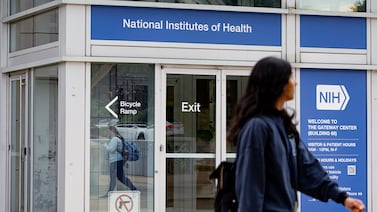Add one more thing to your to-do list before school starts: an application for free and reduced-price lunch.
This year, school district leaders are renewing the push reminding parents to fill out this form. For the past two years, students could get school meals for free whether their parents filled out the form or not — but that won’t be the case this fall.
Beth Wallace, the executive director for food and nutrition services for Jeffco Public Schools, said her district served about 30% more meals than before the pandemic.
At the same time, as the eligibility forms weren’t required, districts saw a drop in the population identified as eligible for subsidized lunches. In Jeffco, eligibility dropped 10% to about 28% of the student population from the 2019-20 school year. Across the country, districts reported similar patterns.
District leaders and child advocates wanted the federal government to allow schools to continue offering free lunches to all students, but the government has reinstated the requirement to prove a student’s eligibility.
Colorado voters will consider a ballot measure in November to offer free school meals for all students, but that won’t change anything for this coming school year. This fall, students must have a new form on file with their school district to determine if they’re eligible for free or reduced-price meals.
“It’s going to be a challenge,” Wallace said. “Now we have second graders who have never gone into this process.”
With the help of some district directors of school meal programs, Chalkbeat got answers to some basic questions about how it all works.
Who has to fill out the form and when does it need to be filled out?
Any parent who feels they need help covering the cost of school meals should fill out the form. The form asks for information about your income and household size that will be used to figure out if you qualify. A family of four would qualify for free lunch if the household income was $36,075 or less. The form also asks for the last four digits of a Social Security number, but that is not required to receive assistance.
There isn’t a strict deadline for when to fill it out. Really, you could fill it out anytime during the school year, but the forms aren’t retroactive. If you wait until October to fill it out, even if you are deemed eligible for free lunch, you would still be charged for meals that your children take from the start of the school year, until whenever the school district approves your form.
And just because you’ve filled out a form in the past, that doesn’t exempt you. The forms are never valid past June 30, so even if you fill one out in May, for example, it expires at the end of June. After July 1, every family needs to fill out the form again.
If a family experiences a change in the middle of the school year — like a new baby, or a loss of income — they can apply to change their status that year. Also, if you change school districts in the middle of the school year, you’ll need to fill out a new form again because districts don’t share the forms with each other.
Are there options for how to fill it out?
Yes! Many parents fill out the forms online, but your district should have paper copies available as well. Additionally, some districts, like Jeffco, set up computer cubicles where parents can come in and fill out these forms while receiving guidance.
Many districts also provide the forms in different languages. If you need help filling out the form or want to request a paper or translated copy, call your district’s lunch services department.
Who sees the information I put on my form?
Usually only one or two people read and process forms, depending on the school district, leaders say.
The school districts have to report how many students applied and were deemed eligible for the federal government to pay for the lunches those students receive, but that information is given to the government in aggregate. The federal departments don’t get copies of the forms parents fill out. District directors say schools never share these forms with immigration officials either.
Other than that, state auditors sometimes request to look at some of the forms from a district to verify that the district is processing forms correctly. “They don’t look at any information beyond that,” said Tony Jorstad, director of nutrition services for the 27J school district.
If I don’t qualify for free lunch, or my child doesn’t eat school food, why should I fill it out?
District leaders point out that there are other benefits to families, and to schools, other than the reduced cost of school meals.
For example, a family that qualifies for free or reduced-price meals might also qualify for waivers or fee reductions for various school or district services and activities like sports, transportation, and technology. Outside of school, internet providers also offer households a reduced price for internet access if children qualify for free or reduced-price lunches.
The amount of funding schools get from the federal government, the state, and the district can depend on how many of their students qualify for the subsidized meals. The forms are used to measure poverty, which may qualify schools to receive more resources for students.
And even without the federal government waiver that allowed all meals to be free for all students, when a school has a particularly high level of students living in poverty, it may still be able to offer free breakfasts and lunches to all students.
If school lunch departments have less money coming in, will students see a difference in the meals that are offered?
School lunch directors say no. Although all districts are expecting fewer students to eat school lunches, because fewer will qualify for subsidies, officials also expect a bump in reimbursement per meal, compared with pre-pandemic levels.
However, supply chain difficulties and increased costs of food could affect what foods show up on menus.
“We really try to plan our menus to work within the reimbursement that we think we’re going to be getting,” Jorstad said. “Right now we’re not looking at changing any menu products of fruit and veggie choices that we offer. We’re pretty proud of the fresh fruit and veggie choices that we offer each day.”
If families don’t qualify for free or reduced-price meals, but still can’t send their child with lunch or money for a school meal, can schools offer other help?
District lunch directors said this is a tough question. Parents should talk to their school about other options. Federal rules prevent school districts from giving school meals away for free.
Often, a school may allow a student to take meals without paying, but will bill the families for the meals. Before the pandemic began, many school districts worried about how much debt families were accumulating. Some schools have a discretionary budget specifically for these situations. In other cases, districts have received donations to help clear debt that students may accumulate for school meals.
“Don’t be afraid to ask,” Jorstad said. “But the first thing, the most important thing, is filling out that form, that information, to figure out that determination.”
Yesenia Robles is a reporter for Chalkbeat Colorado covering K-12 school districts and multilingual education. Contact Yesenia at yrobles@chalkbeat.org.






